|
|
 |
|
Calanoida ( Order ) |
|
|
|
Lucicutiidae ( Family ) |
|
|
|
Lucicutia ( Genus ) |
|
|
| |
Lucicutia clausi (Giesbrecht, 1889) (F,M) | |
| | | | | | | Syn.: | Leuckartia clausi Giesbrecht, 1889; 1892 (p.359, 367, 773, figs.F,M);
? no Lucicutia clausi : Tanaka, 1963 (p.38, figs.F,M); Razouls, 1994 (p.149, figs.F,M); Chihara & Murano, 1997 (p.829, tab.5, Pl.123 (part.): F: a; M: f); | | | | Ref.: | | | Giesbrecht & Schmeil, 1898 (p.111, Rem. F,M); A. Scott, 1909 (p.126, Rem.); Pesta, 1920 (p.529); Sars, 1925 (p.208); Farran, 1929 (p.209, 263); Sewell, 1932 (p.289); Rose, 1933 a (p.192, figs.F,M); Farran, 1936 a (p.112); Wilson, 1942 a (p.192, fig.M); Lysholm & al., 1945 (p.34); Hülsemann, 1966 (p.709, figs.F,M); Owre & Foyo, 1967 (p.76, figs.F,M); Chen & Zhang, 1965 (p.84, figs.F,M); Bradford, 1970 a (p.357, figs.F); Park, 1970 (p.517, figs.F,M, Rem.); Björnberg & al., 1981 (p.646, figs.F,M); Ali-Khan & Ali-Khan, 1982 (p.265, figs.F); Mazzocchi & al., 1995 (p.43, figs.F,M, Rem.); Bradford-Grieve & al., 1999 (p.883, 945, figs.F,M, as clausii); Bradford-Grieve,1999 b (p.96, figs.F,M, Rem., figs.176, 191); Barthélémy, 1999 a (p.8, Fig.17); Lapernat & Razouls, 2002 (p.17, tab. I: Md); Boxshall & Halsey, 2004 (p.133: F; 135: M); Vives & Shmeleva, 2007 (p.328, figs.F,M, Rem.) |  issued from : J.M. Bradford-Grieve in The Marine Fauna of New Zealand: Pelagic Calanoid Copepoda. National Institute of Water and Atmospheric Research (NIWA). NIWA Biodiversity Memoir, 111, 1999. [p.96, Fig.62]. Female (from 36°18.5'S, 165°05.5'E): A, habitus (dorsal); B, genital somite (left lateral side); C, P5. Male (from 41°20'S, 178°48'E): D, P5.
|
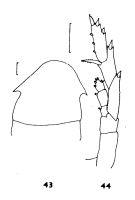 issued from : J.M. Bradford in N.Z. Jl Mar. Freshw. Res., 1970, 4 (4). [p.357, Figs 43-44]. Female (off Kaikoura, New Zealand): 43, Head (dorsal); 44, P5. Scale bars represent 0.1 mm.
|
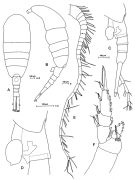 Issued from: M.G. Mazzocchi, G. Zagami, A. Ianora, L. Guglielmo & J. Hure in Atlas of Marine Zooplankton Straits of Magellan. Copepods. L. Guglielmo & A. Ianora (Eds.), 1995. [p.45, Fig.3.4.1]. Female: A, habitus (dorsal); B, idem (lateral left side); C, urosome (lateral left side); D, genital somite (lateral left side); E, A1; F, P1. Nota: Head with poorly developed lateral processes that are rounded and minute in form; in lateral view, the head protrudes over the 1st thoracic segment in almost all specimens. A1 (25-segmented) about 2 segments longer than end of furca. Proportional lengths of urosomites and furca 31:10:10:12:37 = 100.
|
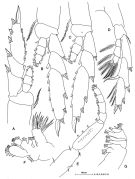 Issued from: M.G. Mazzocchi, G. Zagami, A. Ianora, L. Guglielmo & J. Hure in Atlas of Marine Zooplankton Straits of Magellan. Copepods. L. Guglielmo & A. Ianora (Eds.), 1995. [p.46, Fig.3.4.2]. Female: A, P2; B, P3; C, P4; D, P5; E, Mxp; F, Mx1; G, Mx2.
|
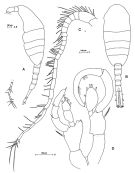 Issued from: M.G. Mazzocchi, G. Zagami, A. Ianora, L. Guglielmo & J. Hure in Atlas of Marine Zooplankton Straits of Magellan. Copepods. L. Guglielmo & A. Ianora (Eds.), 1995. [p.47, Fig.3.4.3]. Male: A, habitus (lateral left side); B, idem (dorsal); C, A1; D, P5. Nota: Proportional lengths of urosomites and furca 15:13:12:12:13:35 = 100
|
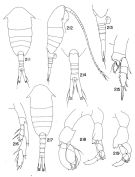 Issued from : T. S. Park in Bull. Mar. Sc., 1970, 20 (2). [p.516, Figs.211-219]; Female: 211, habitus (dorsal); 212, idem (lateral right side); 213, posterior part of metasome and urosome (lateral right side); 214, idem (dorsal); 215, P1 (anterior); 216, P5 (anterior). Nota: Genital segment longer than wide in either dorsal or lateral view. Male: 217, habitus (dorsal); 218, P5 (anterior); 219, left P5 (anterior). Nota: Female and male have their caudal rami about 5 times as long as wide.
|
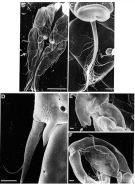 Issued from: M.G. Mazzocchi, G. Zagami, A. Ianora, L. Guglielmo & J. Hure in Atlas of Marine Zooplankton Straits of Magellan. Copepods. L. Guglielmo & A. Ianora (Eds.), 1995. [p.49, Fig.3.4.5]. Male (SEM preparation): C, detail of curious cusshion-like protuberance bearing hairy seta on inner margin of basipod 1 of P1; D, extarnal spine of exopod 2 of P2 (white arrow in B); E, basipod 2 of left P5 with protrusion bearing cluster of denticles (white arrow); F, right P5 with leaf-like endopodal segment 2. Bars: C 0.050 mm; B, D, E, F 0.010 mm.
|
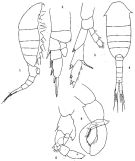 issued from: Q.-c Chen & S.-z. Zhang in Studia Marina Sinica, 1965, 7. [Pl.33, 1-6]. Female (from E China Sea): 1, habitus (lateral right side); 2, left P1 (posterior); 3, left P5 (posterior). Male: 4, habitus (dorsal); 5, left P5 (posterior); 6, right P5 (posterior).
|
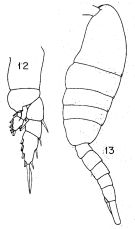 Issued from : K. Hülsemann in Bull. Mar. Sc., 1966, 16 (4). [p.708, Figs.12-13]. Female: 12, P1. Male: 13, habitus (lateral left side).
|
 Issued from : K. Hülsemann in Bull. Mar. Sc., 1966, 16 (4). [p.722, Figs.87-91]. Female: 87, P5; 88, habitus (lateral right side); 90, head (dorsal; from Red Sea); 91, habitus (dorsal; from tropical Atlantic). Male: 89,head (dorsal; from tropical Atlantic)
|
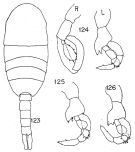 Issued from : K. Hülsemann in Bull. Mar. Sc., 1966, 16 (4). [p.728, Fig.123-126]. Male: 123, habitus (dorsal); 124, P5; 125, left P5 (another specimen); 126, left P5 (another specimen).
|
 issued from : S. Ali-Khan & J. Ali-Khan in Crustaceana, 1982, 43 (3). [p;266, Figs.1-4]. Female (from 24°09'N, 64°27'E): 1, habitus (dorsal); 2, forehead (dorsal); 3, P5; 4, last thoracic segment and urosome (lateral, left side). Nota: The specimen resembles more the western North Atlantic form than the Red Sea one.
|
 issued from : R.-M. Barthélémy in These Doc. Univ. Provence (Aix-Marseille I), 1999. [Fig.17, A]. Female: A, external ventral view genital double-somite. gn = gonoporal slit; opercular pad arrowed. Scale bar: 0.050 mm.
|
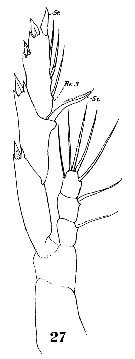 Issued from : W. Giesbrecht in Systematik und Faunistik der Pelagischen Copepoden des Golfes von Neapel und der angrenzenden Meeres-Abschnitte. - Fauna Flora Golf. Neapel, 1892. Atlas von 54 Tafeln. [Taf. 19, Fig.27]. As Leuckartia clausii. Female: 27, P5.
|
 Issued from : W. Giesbrecht in Systematik und Faunistik der Pelagischen Copepoden des Golfes von Neapel und der angrenzenden Meeres-Abschnitte. - Fauna Flora Golf. Neapel, 1892. Atlas von 54 Tafeln. [Taf. 19, Figs.5, 6]. As Leuckartia longiserrata. Male: 5, left A1 (distal segments with geniculation); 6, right A1 (segments 22 to 25); ventral view. Aes = aesthetasc; Sdi distal setae; St = terminal seta; Sp = posterior seta
|
 Issued from : W. Giesbrecht in Systematik und Faunistik der Pelagischen Copepoden des Golfes von Neapel und der angrenzenden Meeres-Abschnitte. - Fauna Flora Golf. Neapel, 1892. Atlas von 54 Tafeln. [Taf. 38, Fig.37]. As Leuckartia longiserrata. Male: 37, habitus (dorsal).
|
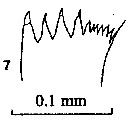 issued from : P.E. Lapernat & C. Razouls in Vie Milieu, 2002, 52 (1). [p.28, Pl. VI, fig.7]. Masticatory edge of Md gnathobase female (from off Malta, Mediterranean Sea). Nota: Itoh's index: 534.3 (number of teeth : 10)
|
 Issued from : W. Giesbrecht in Systematik und Faunistik der Pelagischen Copepoden des Golfes von Neapel und der angrenzenden Meeres-Abschnitte. - Fauna Flora Golf. Neapel, 1892. Atlas von 54 Tafeln. [Taf. 19, Figs.12, 13, 14]. As Leuckartia clausii. Male: 12, left P5 (from Pacific Ocean); 13, right P5 (from Pacific Ocean); 14, P5 (anterior view, from Gulf of Neapel; )
|
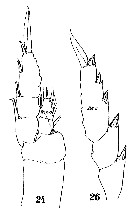 Issued from : W. Giesbrecht in Systematik und Faunistik der Pelagischen Copepoden des Golfes von Neapel und der angrenzenden Meeres-Abschnitte. - Fauna Flora Golf. Neapel, 1892. Atlas von 54 Tafeln. [Taf. 19, Figs.24, 26]. As Leuckartia clausii. Male: 24, P1 (posterior view); 26, exopod of P2.
|
 Lucicutia clausi Lucicutia clausi female: 1 - Characters following not combined : Prosome about 3 times longer than urosome. Cephalosome with slightly projecting and rounded anterior corners and well developed lateral spinous projections; anal somite about as long as wide; caudal rami 11.7 times longer than wide and bowed outwards at base, leaving elliptical space between rami proximally. 2 - P1 with 2-segmented endopod. 3 - Cephalosome not with 2 pairs of lateral spinous projections, but with other forms. 4 - A1 extending to end of caudal ramus or 1 to 2 segments beyond. 5 - Caudal rami 3 to 4 times longer than wide. 6 - Terminal setal element of P5 very short, less than 1/3 lenght of 3rd exopodal segment. 7 - A1 extending to tip of caudal ramus; anal somite longer than preceding somite; cephalosome with 1 strong spinous projection laterally or with rounded protrusions.
|
 Lucicutia clausi Lucicutia clausi male: 1 - P1 with 2-segmented endopod; 2 - Caudal rami less than 10 times longer than wide. 3 - Inner distal corner of basis of P5 without strong spine. 4 - Basis of left P5 ornamented differently from L. oblonga. 5 - Caudal rami about 3 to 5 times longer than wide. 6 - A1 at most reaching to end of caudal rami; basis of left P5 different from L. longiserrata. 7 - Cephalosome with strong lateral spinous projections (in dorsal view); right A1 reaching only to tip of caudal rami; inner margin of basis of right P5 with small tooth-like projection; inner distal corner of basis of left leg not ending in single point. 8 - Lateral spinous processes on cephalosome directed posterolaterally; caudal rami about 5 times longer than wide.
|
 Issued from : C. Razouls in Ann. Inst. océanogr., Paris, 1994, 70 (1). [p.149]. Caractéristiques morphologiques de Lucicutia clausi femelle et mâle adultes. Terminologie et abbréviations: voir à Calanus propinquus. - La variabilité de la longueur des pointes latérales de la tête est à souligner. Nota: Cette forme essentiellement subtropicale et tempérée a été toutefois signalée par Hopkins (1985, p.167) dans le Détroit de Croker (Péninsule Antarctique) comme rare et bathypélagique.
| | | | | Compl. Ref.: | | | Cleve, 1904 a (p.192); Rose, 1924 d (p.480); Massuti Alzamora, 1942 (p.111); Sewell, 1948 (p.349, 503, 509, 519, 521, 547, 558, 567); C.B. Wilson, 1950 (p.255); Bogorov, 1958 (p.152); Fagetti, 1962 (p.29); Cervigon, 1962 (p.181, tables: abundance distribution); V.N. Greze, 1963 a (tabl.2); Shmeleva, 1963 (p.141); Björnberg, 1963 (p.53, Rem.); De Decker & Mombeck, 1964 (p.13); Grice & Hulsemann, 1965 (p.224); Shmeleva, 1965 b (p.1350, lengths-volume -weight relation); Neto & Paiva, 1966 (p.27, Table III); Mazza, 1966 (p.71); Pavlova, 1966 (p.44); Fleminger, 1967 a (tabl.1); Delalo, 1968 (p.138); Evans, 1968 (p.13); Park, 1970 (p.477); Timonin, 1971 (p.281, trophic group); Deevey, 1971 (p.224); Bainbridge, 1972 (p.61, Appendix Table II: vertical distribution); Binet & al., 1972 (p.68); Apostolopoulou, 1972 (p.328, 361); Roe, 1972 (p.277, tabl.1, tabl.2); Björnberg, 1973 (p.343, 387); Vives & al., 1975 (p.49, tab.II); Deevey & Brooks, 1977 (p.256, tab.2, Station "S"); Carter, 1977 (1978) (p.36); Dessier, 1979 (p.187, 201, 206); Vaissière & Séguin, 1980 (p.23, tab.2); Vives, 1982 (p.293); Kovalev & Shmeleva, 1982 (p.84); Greze & al., 1983 (p.17); Scotto di Carlo & Ianora, 1983 (p.150); De Decker, 1984 (p.317); Cummings, 1984 (p.163, Table 2); Guangshan & Honglin, 1984 (p.118, tab.); Scotto di Carlo & al., 1984 (1042); Regner, 1985 (p.11, Rem.: p.35); Brenning, 1985 a (p.16, 28, Table 2); 1986 (p.11, Rem.); Brinton & al., 1986 (p.228, Table 1); Chen Y.-Q., 1986 (p.205, Table 1: abundance %, Table 2: vertical distribution); Madhupratap & Haridas, 1986 (p.105, tab.1); Wishner & Allison, 1986 (tab.2); Lozano Soldevilla & al., 1988 (p.59); Madhupratap & Haridas, 1990 (p.305, fig.3, vertical distributiion night/day; fig.7: cluster); Suarez & al., 1990 (tab.2); Scotto di Carlo & al., 1991 (p.271); Yoo, 1991 (tab.1); Suarez & Gasca, 1991 (tab.2); Suarez, 1992 (App.1); Ashjian & Wishner, 1993 (p.483, abundance, species group distributions); Shih & Young, 1995 (p.70); Park & Choi, 1997 (Appendix); Hure & Krsinic, 1998 (p.63, 102); Padmavati & al., 1998 (p.347); Suarez-Morales & Gasca, 1998 a (p.110); Lapernat, 1999 (p.20, 55); Lapernat, 2000 (tabl. 3, 4); Razouls & al., 2000 (p.343, Appendix); Seridji & Hafferssas, 2000 (tab.1); Lopez-Salgado & al., 2000 (tab.1); Lapernat & Razouls, 2001 (p.123, tab.1); Holmes, 2001 (p.17); Vukanic, 2003 (139, tab.1); Hsiao & al., 2004 (p.326, tab.1); Lo & al., 2004 (p.89, tab.1); Kazmi, 2004 (p.228); Isari & al., 2006 (p.241, tab.II); Dias & Araujo, 2006 (p.52, Rem., chart); Koppelmann & Weikert, 2007 (p.266: tab.3); Hwang & al., 2007 (p.24); Dur & al., 2007 (p.197, Table IV); Lopez Ibarra, 2008 (p.1, Table 1, fig.11: abundance); Gaard & al., 2008 (p.59, Table 1, N Mid-Atlantic Ridge); Hafferssas & Seridji, 2010 (p.353, Table 3); Williamson & McGowan, 2010 (p.273, Table 3, Pacific central gyres: N and S); Schnack-Schiel & al., 2010 (p.2064, Table 2: E Atlantic subtropical/tropical); Dias & al., 2010 (p.230, Table 1); Mazzocchi & Di Capua, 2010 (p.425); Medellin-Mora & Navas S., 2010 (p.265, Tab. 2); Hsiao S.H. & al., 2011 (p.475, Appendix I); Andersen N.G. & al., 2011 (p.71, Fig.3: abundance); Uysal & Shmeleva, 2012 (p.909, Table I); in CalCOFI regional list (MDO, Nov. 2013; M. Ohman, comm. pers.); Bonecker & a., 2014 (p.445, Table II: frequency, horizontal & vertical distributions); Lopez-Ibarra & al., 2014 (p.453, fig.6, biogeographical affinity); Mazzocchi & al., 2014 (p.64, Table 4, abundance); Benedetti & al., 2016 (p.159, Table I, fig.1, functional characters); El Arraj & al., 2017 (p.272, table 2); Benedetti & al., 2018 (p.1, Fig.2: ecological functional group); Belmonte, 2018 (p.273, Table I: Italian zones); Hure M. & al., 2018 (p.1, Table 1: abundance, % composition)
| | | | NZ: | 18 | | |
|
Distribution map of Lucicutia clausi by geographical zones
|
| | | | | | | | | | | | | | | 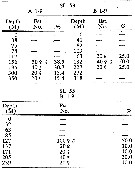 issued from : H.B. Owre & M. Foyo in Fauna Caribaea, 1, Crustacea, 1: Copepoda. Copepods of the Florida Current. 1967. [p.76, Table 33]. issued from : H.B. Owre & M. Foyo in Fauna Caribaea, 1, Crustacea, 1: Copepoda. Copepods of the Florida Current. 1967. [p.76, Table 33].
Vertical distribution of Lucicutia clausii at the ''40-Mile station'' in the Florida Current (± 25°35'N, 79°27'W).
SL 53: 18 V 1958; SL 55: 21 VII 1958. A: during midday; B;: during midnight. |
 issued from : A.A. Shmeleva in Bull. Inst. Oceanogr., Monaco, 1965, 65 (n°1351). [Table 6: 31 ]. Lucicutia clausi (from South Adriatic). issued from : A.A. Shmeleva in Bull. Inst. Oceanogr., Monaco, 1965, 65 (n°1351). [Table 6: 31 ]. Lucicutia clausi (from South Adriatic).
Dimensions, volume and Weight wet. Means for 50-60 specimens. Volume and weight calculated by geometrical method. Assumed that the specific gravity of the Copepod body is equal to 1, then the volume will correspond to the weight. |
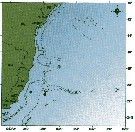 issued from : C. de O. Dias & A.V. Araujo in Atlas Zoopl. reg. central da Zona Econ. exclus. brasileira, S.L. Costa Bonecker (Edit), 2006, Série Livros 21. [p.52]. issued from : C. de O. Dias & A.V. Araujo in Atlas Zoopl. reg. central da Zona Econ. exclus. brasileira, S.L. Costa Bonecker (Edit), 2006, Série Livros 21. [p.52].
Chart of occurrence in Brazilian waters (sampling between 22°-23° S)
Nota: sampling only 2 specimens. |
 Issued from : M. Madhupratap & P. Haridas in J. Plankton Res., 12 (2). [p.310, Fig.3]. Issued from : M. Madhupratap & P. Haridas in J. Plankton Res., 12 (2). [p.310, Fig.3].
Vertical distribution of calanoid copepod (mean +1 SE), abundance No/100 m3. 13- Lucicutia clausi .
Night: shaded, day: unshaded.
Samples collected from 6 stations located off Cochin (India), SE Arabian Sea, November 1983, with a Multiple Closing Plankton Net (mesh aperture 300 µm), in vertical hauls at 4 depth intervalls (0-200, 200-400, 400-600, 600-1000 m). |
| | | | Loc: | | | Antarct. (Peninsula), sub-Antarct. (SE Pacif.), South Africa (E), Namibia, Congo, G. of Guinea, Ivorian shelf, off Mauritania-NW Cape Verde Is., off Mauritania, Mauritania-Morocco, Canary Is., off Madeira, off Portugal, off Azores, Brazil, off Rio de Janeiro, off Macaé, off Amazon, Caribbean Sea, Caribbean Colombia, Cariaco Basin, G. of Mexico, Florida, Sargasso Sea, off Bermuda (Station "S"), off Cape Hatteras, off W Ireland (in Thompson, 1903 a), Ibero-moroccan Bay, Medit. (Alboran Sea, NW Basin, Ligurian Sea, Tyrrhenian Sea, Malta, Adriatic Sea, Ionian Sea, Johnston Bank, Aegean Sea, Lebanon Basin), Red Sea, G. of Aden, Arabian Sea, Pakistan, Natal, Indian, Indonesia-Malaysia, China Seas (Yellow Sea, East China Sea, South China Sea), Taiwan (S, E, N: Mienhua Canyon), S Korea, ? Japan, Pacif. (temperate & tropical), Pacific (central gyres: N and S), Pacif. (W equatorial), Australia (Great Barrier), Tasman Sea, New Zealand (Kaikoura, off E North Island, NE), California, Gulf of California, Hawaii, Peru, N Chile, Straits of Magellan (Pacific area).
After Markhaseva & Ferrari (2005, p.1098) this species should not be considered an inhabitant of antarctic waters. | | | | N: | 115 | | | | Lg.: | | | (21) F: 2,1-1,6; M: 1,9-1,6; (34) F: 1,98-1,8; M: 1,92-1,85; (35) F: 1,8; M: 1,8-1,7; (46) F: 2,05-1,9; M: 1,85-1,7; (199) F: 1,82-1,67; M: 1,75; (237) F: 1,95; (290) F: 1,85-2; M: 1,8-1,9; (313) F: 1,8; (340) F: 1,9-1,8; (402) F: 1,6; (449) F: 2,05-1,9; M: 1,85-1,7; (909) F: 1,6-1,9; M: 1,7-1,8; (1108) F: 1,82-2,16; M: 1,78-1,92; {F: 1,60-2,16; M: 1,60-1,92} | | | | Rem.: | epi-mesopelagic. Sampling depth (off Malta: 2000-3000 m (Lapernat & Razouls, 2001). Sargasso Sea: 0-1000 m (Deevey & Brooks, 1977, Station "S");
After Björnberg (1963, p.53) this spcies was found in cool southern waters of high salinity for the first time off Brazilian coast.
For Hülsemann (1966, p.709) this species is the only small species with spine-like protrusions on the sides of the head which can be straight or turned backwards; they can be missing as already Giesbrecht (1892) pointed out. Females and males with only indication of a protrusion on the sides of the head were found in the western North Atlantic (Figs.91 and 123).
According to Mazzocchi & al (1995, p.43) in the specimens from Straits of Magellan (Pacific area) these protrusions are similar to those reported by Hülsemann (1966) for the tropical Atlantic, but differ from the latter forms by more slender and longer caudal rami.
For Markhaseva & Ferrari (2005, p.1098) the southernmost locality is the Strait of Magellan (Mazzocchi & al., 1995) and should not be considerd an inhabitant of antarctic waters, but indicated near the Antarctic Peninsule.
Timonin (1971, p.282) considers the trophic interrelations in the equatorial and tropical Indian Ocean, and divides the plankters into 6 trophic groups from the litterature and the results of studies of mouth-parts structure and intestine content. This species is a coarse-filter feeder herbivorous.
After Benedetti & al. (2018, p.1, Fig.2) this species belonging to the functional group 4 corresponding to small filter feeding herbivorous and mixed feeding omnivorous (mostly broadcasters).
R. Stephen : Data sheets of NIO, Kochi, India (on line). | | | Last update : 24/10/2022 | |
|
|
 Any use of this site for a publication will be mentioned with the following reference : Any use of this site for a publication will be mentioned with the following reference :
Razouls C., Desreumaux N., Kouwenberg J. and de Bovée F., 2005-2025. - Biodiversity of Marine Planktonic Copepods (morphology, geographical distribution and biological data). Sorbonne University, CNRS. Available at http://copepodes.obs-banyuls.fr/en [Accessed August 27, 2025] © copyright 2005-2025 Sorbonne University, CNRS
|
|
 |
 |



























